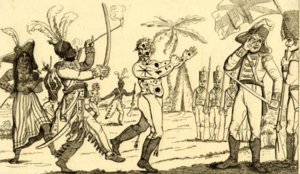Roundhead (Wyandot) facts for kids
Quick facts for kids
Roundhead
|
|
|---|---|
| Born | c. 1760 |
| Died | c. August 1813 (age 52–53) |
| Nationality | Wyandot |
| Other names | Bark Carrier, Stayeghtha, Stiahta |
| Known for | War of 1812 |
| Relatives | Jean-Baptiste, Leatherlips, Tharoutorea, Warrow |
Roundhead (born around 1760 – died 1813) was an important Wyandot chief. He was also known by names like Bark Carrier and Stayeghtha. Roundhead was a key leader in Tecumseh's confederacy, a group of Native American tribes who worked together against the United States. He played a big part in the War of 1812. He passed away from natural causes a short time before Tecumseh was killed in battle.
Contents
Early Life and Leadership
Roundhead was born around 1760 near the Sandusky River in what was then New France. This area is now part of Ohio. He became a chief of the Wyandot people in the Sandusky region. Later, he moved to Brownstown and joined Tecumseh in his efforts against the Americans.
Not much is known about Roundhead's early life before 1794. In that year, he led Wyandot warriors at the Battle of Fallen Timbers. This was a time when different Wyandot groups had different ideas about how to deal with the United States.
In 1795, Chief Roundhead took part in the Treaty of Greenville. This agreement meant that Native American tribes gave up a large part of what is now Ohio and some of Indiana. In 1800, he also signed a treaty with the British, giving them land on the Canadian side of the Detroit River.
After the Treaty of Greenville, Roundhead decided to support Tecumseh. He joined Tecumseh's fight against the Americans. In 1810, Roundhead was involved in the decision to remove his brother, Leatherlips, from his position as chief. Leatherlips had wanted to work with white settlers and had sold Native American land. This was against the goals of Tecumseh's confederacy. It's believed that Leatherlips was removed for political reasons, even though other reasons were given. Roundhead led the council that made this decision.
Roundhead in the War of 1812
During the War of 1812, Roundhead was a very important leader. He was second only to Tecumseh among the Native American forces working with British Colonel Henry Procter.
Roundhead fought in several battles:
- The Battle of Brownstown on August 5, 1812.
- The Battle of Maguaga on August 9, 1812.
After the Battle of Maguaga, Tecumseh gave Roundhead a special sash that he had received from General Isaac Brock. Tecumseh felt that Roundhead, as an older and more skilled warrior, deserved it. However, Roundhead chose not to wear the sash. He did not want to make other war chiefs feel jealous.
A few days later, Roundhead helped capture Fort Detroit during the Siege of Detroit on August 15. He then joined Major Adam Muir for the British takeover of Fort Miami in September 1812. He also fought in the Siege of Fort Meigs in April and May 2013. Sadly, one of Roundhead's brothers, Jean-Baptiste, died during this siege.
Capturing General Winchester
Roundhead's most famous action in the War of 1812 happened at the Second Battle of the River Raisin on January 22, 1813. The Native American and British forces won a huge victory against the Americans. Tecumseh was not at this battle, so he gave command of the Native American fighters to Roundhead. Another Wyandot chief, Walk-in-the-Water, also helped lead.
They led about 800 Native Americans and 597 British soldiers against 1,000 American troops. The Americans were surprised early in the morning. This battle caused the most American deaths of any battle in the War of 1812.
Early in the fight, Roundhead captured the American general, James Winchester. Winchester was not ready for battle and was taken by surprise. Roundhead took his uniform, which led to stories that Winchester was captured in his nightshirt. With their general captured, the American troops suffered heavy losses. Roundhead brought Winchester to Colonel Procter, who then made the general surrender his army. Forty percent of Winchester's men were killed, and 547 were taken prisoner. After the battle, Roundhead helped Procter's troops quickly retreat back into Upper Canada.
Death and Legacy
Roundhead passed away from natural causes in August 1813. This was shortly before the Battle of the Thames in October 1813. General Procter wrote that Roundhead's death was a "serious loss" for both the Native American and British causes.
For many years, Roundhead, who strongly supported Tecumseh, had disagreed with other Wyandot groups. These other groups supported Chief Tarhe and wanted peace with the Americans. After Tecumseh's forces were defeated at the Battle of the Thames, the disagreements among the Wyandot ended. They began to talk about peace with the Americans.
In 1832, the place where Roundhead's original Wyandot village was located became a small community called Roundhead, Ohio. It is in Roundhead Township in Hardin County, Ohio.


